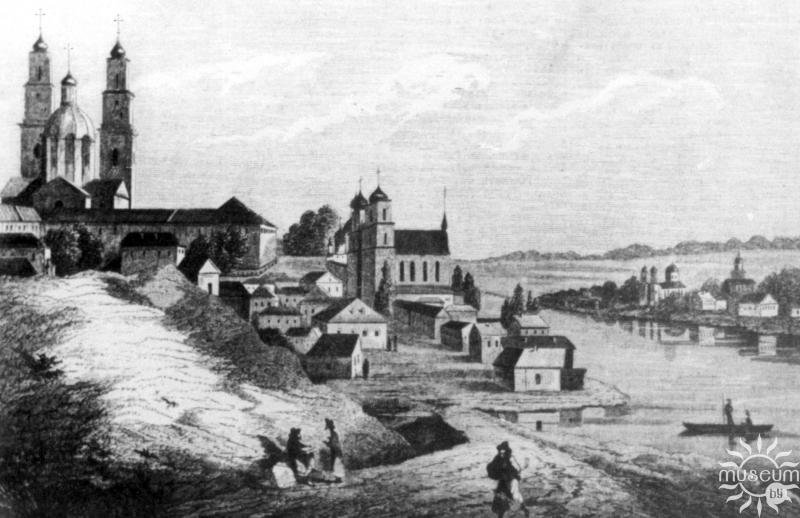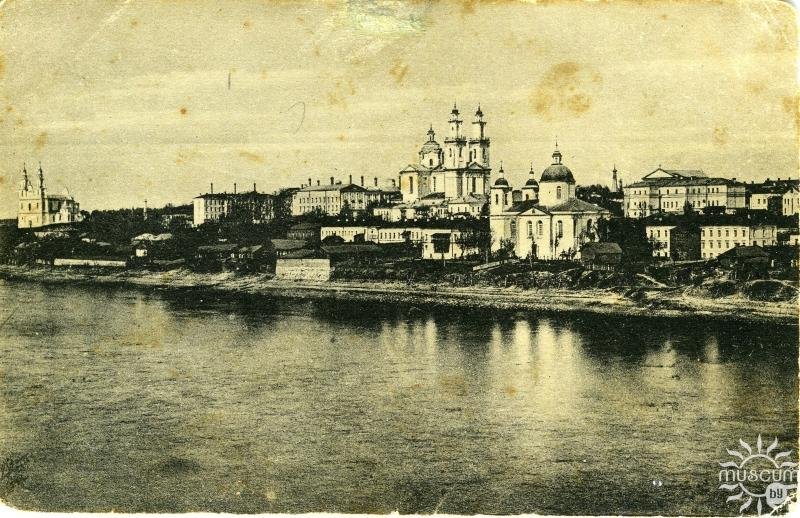
Development of Nizhne-Pokrovskaya Street, view of the Franciscan Church of St. Anthony (late 18th century)

View of the building of Nizhne-Pokrovskaya St. from the side of the Western Dvina (late 19th — early 20th cc.)
Nizhne-Pokrovskaya Street is one of the oldest streets in Polotsk. Historical sources confirm its existence already in the second half of the 11th — beginning of the 12th century. From the 13th century the street was densely populated, served as one of the main streets in the city, it was crossed by the Dvina River to the city markets, churches, synagogues, Catholic and Orthodox monasteries were located on it, the richest and most influential citizens lived there.
The first known name of this street was Velikaya Street. In the last quarter of the 18th century (in connection with the construction of St. Pokrovskaya Church) it was renamed into Nizhne-Pokrovskaya Street, in 1919 — into Lenin Street, and in 2008 the street again returned the name Nizhne-Pokrovskaya. It received its current direction in accordance with the classicist plan of Polotsk developed and approved in the late 18th century, which gave the layout of the historical center of the city the features of regularity.
House No. 20 on Nizhne-Pokrovskaya Street is the building of the residential building of the former Franciscan Catholic monastery. The monument, erected in 1778, is an example of the Baroque, characterized by complexity of forms, dynamism, striving for grandeur and splendor.
The current building adjoined the eastern wall of the church of St. Anthony (built in 1763-1775), which has not survived to this day.
The monastery of the Franciscan order operated in Polotsk until 1833, later it was closed, the church and the dwelling building were handed over to the Orthodox Church. In 1838 the former church of St. Anthony was re-consecrated into the Church of the Protection of the Saint Mary (which was called Novo-Pokrovskaya among the townspeople). However, a year later, in 1839, when the walls of the brick building of the former church were covered with numerous cracks due to significant sedimentation of the foundations, the Novo-Pokrovskaya Church together with the former residential building of the monastery was closed.
In 1860 the buildings of the former Franciscan monastery were handed over for dismantling to a private person for 2 thousand rubles in silver. However, only the former church was dismantled, in place of which until the end of the 19th century was erected a two-storey house, which adjoined the western wall of the surviving residential monastery building. During the Great Patriotic War the two-storied building of the 19th century was lost, and in its place a two-storied annex was built again in 1986-87. The buildings of the former Franciscan monastery of the 19th century were preserved and have survived to our time.
In the middle of the 19th century the former monastery building was adapted for administrative purposes, and part of the premises were given for housing.
In 1917 the building housed the Polotsk committee of the RSDLP. After the Great Patriotic War for some time the building housed the city council, regional and city party committees, later — the services of the Polotsk city police department, and since 2012 — Polotsk District Department of Internal Affairs.
According to the Decree of the Council of Ministers of the Republic of Belarus of 14.05.2007 № 578 the house № 20 on Nizhne-Pokrovskaya Street is included in the State list of Historical and Cultural Heritage of the Republic of Belarus.
